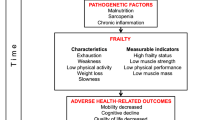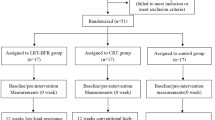Abstract
Background and aims: Frail elderly people often suffer from a combination of unintentional weight loss and/or low body mass index, as well as a low physical activity level. No studies have investigated the effect of physical training alone or in combination with nutritional intervention on aerobic capacity in frail elderly people. The aim of this pilot study was to determine if a physical training program can affect aerobic capacity in frail elderly people. Methods: Ninety-six community-dwelling frail elderly people (58 women) were included in the study. Subjects were randomized to four different groups: i) physical training program (aerobic, muscle strength, balance), ii) a nutritional intervention program (individually targeted advice and group sessions), iii) a combination of these interventions, and iv) a control group. At baseline, subjects were screened for aerobic capacity, leg muscle strength, spirometry, heart disease and cardiovascular drugs. Aerobic capacity and leg muscle strength were analyzed immediately after the 3-month intervention period (1st follow-up), and after another 6 months (2nd follow-up). Results: Subjects mean age was 83 years. The mean compliance rate with the physical training program was 65%. There were no observed effects on aerobic capacity measured as maximal workload, or work time, with or without ?-receptor blockade. Subjects in the training groups without lung disease significantly increased maximal work time when compared with subjects with lung disease. Physical training significantly increased lower extremity muscle strength compared with nutrition alone at the 1st follow-up. No serious adverse events occurred during assessment or physical training. Conclusions: Further studies with larger sample sizes and a more specific aerobic component in the training program are necessary before any further conclusions can be drawn.
Similar content being viewed by others
References
Statistics Sweden, (home page on the internet) cited 2007 June 28. Available from: http://www.scb.se/statistik/BE/BE0401/2003M00/BE0401_2004A01_SM_BE18SM0401.pdf
Åstrand PO. Physical activity and fitness. Am J Clin Nutr 1992; 55: 1231S–6S.
Stathokostas L, Jacob-Johnson S, Petrella RJ, Paterson DH. Longitudinal changes in aerobic power in older men and women. J Appl Physiol 2004; 97: 781–9.
Era P, Schroll M, Hagerup L, Schultz-Larsen Jürgensen K. Changes in Bicycle Ergometer test performance and survival in men and women from 50 to 60 and from 70 to 80 years of age: Two longitudinal studies in the Glostrup (Denmark) population. Gerontology 2001; 47: 136–44.
Ferretti G, Antonutto G, Denis C et al. The interplay of central and peripheral factors limiting maximal O2 consumption in men after prolonged bed rest. J Physiol 1997; 501: 677–86.
Aliverti A, Macklem PT. How and why exercise is impaired in COPD. Respiration 2001; 68: 229–39.
Coats AJ. Exercise and heart failure. Cardiol Clin 2001; 19: 517- 524, xii–xiii.
Tesch PA. Exercise performance and β-blockade. Sports Med 1985; 2: 389–412.
Van Baak MA. ?-Adrenoceptor blockade and exercise, an update. Sports Med 1988; 4: 209–25.
Fried LP, Tangen CM, Walston J et al. Frailty in older adults: evidence for a phenotype. J Gerontol A Biol Sci Med Sci 2001; 56: M146–M56.
Chin A Paw MJ, Dekker JM, Feskens EJ, Schouten EG, Kromhout D. How to select a frail elderly population? A comparison of three working definitions. J Clin Epidemiol 1999; 52: 1015–21.
Vaitkevicius PV, Ebersold C, Shah MS et al. Effects of aerobic exercise training in community-based subjects aged 80 and older: a pilot study. J Am Geriatr Soc 2002; 50: 2009–13.
Binder EF, Schechtman KB, Ehsani AA et al. Effects of exercise training on frailty in community-dwelling older adults: Results of a randomized controlled trial. J Am Geriatr Soc 2002; 50: 1321–8.
Chandler JM, Duncan PW, Kochersberger G, Studenski S. Is lower extremity strength gains associated with improvements in physical performance and disability in frail community-dwelling elders? Arch Phys Med Rehabil 1998; 79: 24–30.
Mattiasson-Nilo I, Sonn K, Johannesson K, Gosman-Hedström G, Person G.B, Grimby G. Domestic activities and walking in elderly: Evaluation from a 30-hour heart rate recording. Aging Clin Exp Res 1990; 2: 191–8.
Frändin K, Grimby G. Assessment of physical activity, fitness and performance in 76-year-olds. Scand J Med Sci Sports 1994; 4: 41–6.
Callahan CM, Unverzagt FW, Hui SL, Perkins AJ, Hendrie HC. Six-item screener to identify cognitive impairment among potential subjects for clinical research. Med Care 2002; 40: 771–81.
Wetterqvist H, Grimby G, Lernfelt B, Svanborg A. Exercise testing in women and men aged 75–77 years. Cardiology 2002; 98: 92–8.
Borg GA. Psychophysical bases of perceived exertion. Med Sci Sports Exerc 1982; 14: 377–81.
Phillips WT, Batterham AM, Julie E, Valenzuela JE, Burkett LN. Reliability of maximal strength testing in older adults. Arch Phys Med Rehabil 2004; 85: 329–34.
American College of Sports Medicine (ACSM). ACSM’s guidelines for exercise testing and prescription. Williams & Wilkins, 1993.
Rydwik E, Lammes E, Frändin K, Akner G. Effects of a physical training and nutritional intervention program for frail elderly people over age 75. A randomized controlled pilot treatment trial. Aging Clin Exp Res 2008; 20: 159–70.
Lemura LM, von Duvillard SP, Mookerjee S. The effects of physical training of functional capacity in adults. Ages 46 to 90: a meta-analysis. J Sports Med Phys Fitness 2000; 40: 1–10.
Astrand PO. Quantification of exercise capability and evaluation of physical capacity in man. Prog Cardiovasc Dis 1976; 19: 51–67.
Vincent KR, Braith RW, Ross AF, Kallas HE, Lowenthal DT. Improved cardiorespiratory endurance following 6 months of resistance exercise in elderly men and women. Arch Intern Med 2002; 162: 673–8.
Timonen L, Rantanen T, Ryynänen O-P, Taimela S, Timonen TE, Sulkava R. A randomized controlled trial of rehabilitation after hospitalization in frail older women: effects on strength balance, and mobility. Scand J Med Sci Sports 2002; 12: 186–92.
Fiatarone MA, O’Neill EF, Ryan ND et al. Exercise training and nutritional supplementation for physical frailty in very elderly people. N Engl J Med 1994; 330: 1769–75.
Robergs RA. An exercise physiologist’s “contemporary” interpretations of the “ugly and creaking edifices” of the VO2max concept. JEP online 2001; 4: 1–44.
Hollenberg M, Ngo LH, Turner D, Tager IB. Treadmill exercise testing in an epidemiological study of elderly subjects. J Gerontol Biol Sci Med Sci 1998; 53A: B259–67.
Harms CA. Does gender affect pulmonary function and exercise capacity? Respir Physiol Neurobiol 2006; 151: 124–31.
Author information
Authors and Affiliations
Corresponding author
Rights and permissions
About this article
Cite this article
Rydwik, E., Gustafsson, T., Frändin, K. et al. Effects of physical training on aerobic capacity in frail elderly people (75+ years). Influence of lung capacity, cardiovascular disease and medical drug treatment: a randomized controlled pilot trial. Aging Clin Exp Res 22, 85–94 (2010). https://doi.org/10.1007/BF03324820
Received:
Accepted:
Published:
Issue Date:
DOI: https://doi.org/10.1007/BF03324820




